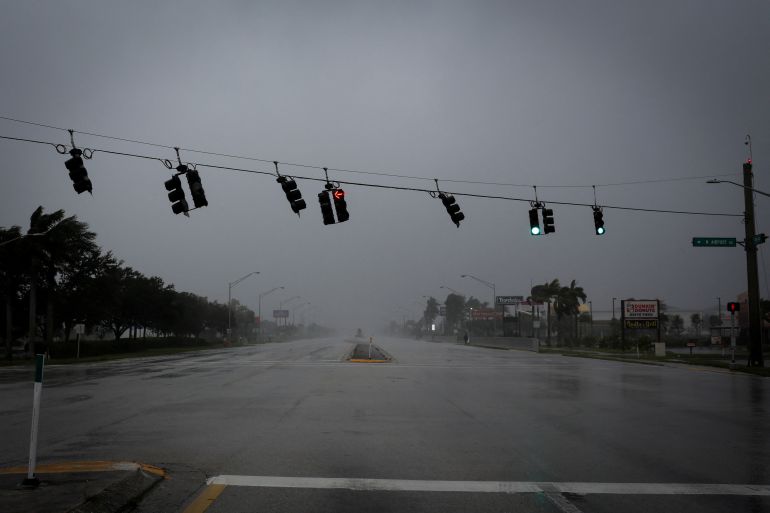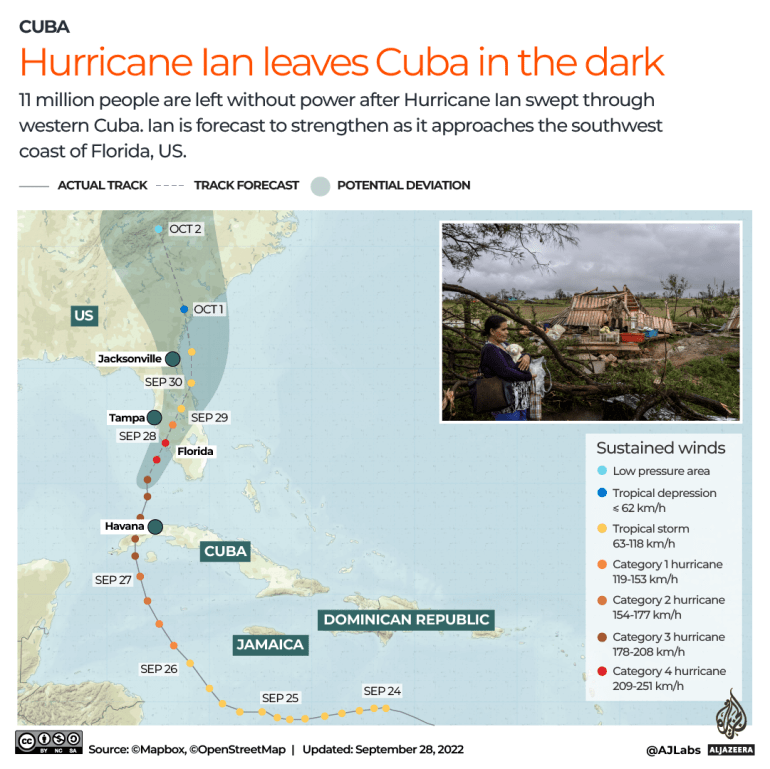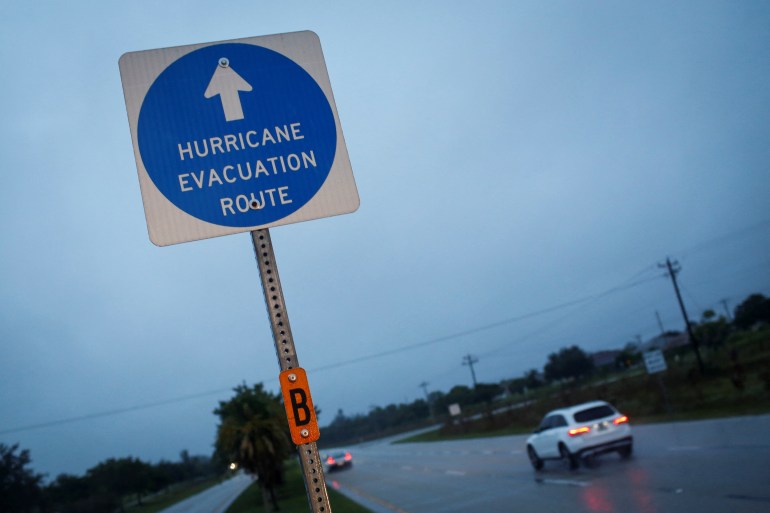Where is Hurricane Ian now headed and how to prepare for it?
Ian makes landfall in US state of Florida as ‘extremely dangerous’ Category 4 hurricane after leaving Cuba in the dark.

Hurricane Ian has made landfall in the US state of Florida as an “extremely dangerous” Category 4 storm, a day after it tore into western Cuba and left millions in the dark.
Here is what we know about the tropical storm so far:
What happened and when?
- Ian made landfall in Florida shortly after 3pm (19:00 GMT) on Wednesday near Cayo Costa, on the US state’s western Gulf Coast, the US National Hurricane Center (NHC) said.
- At landfall, it brought sustained winds of about 240 kilometres per hour (150 miles per hour), putting it just shy of a Category 5 designation on the Saffir-Simpson scale, the most severe classification for storms.
- A Category 4 storm on the five-step Saffir-Simpson scale carries winds of at least 209km (130 miles) an hour and up to 251km (156 miles) per hour.
305 PM EDT 28 Sep — Hurricane #Ian has made landfall as an extremely dangerous Category 4 hurricane near Cayo Costa, Florida with maximum sustained winds at 150 mph. The minimum pressure from Air Force Reconnaissance Hurricane Hunters was 940 mb.
Latest: https://t.co/tnOTyfORCw pic.twitter.com/O3agPDOZHk
— National Hurricane Center (@NHC_Atlantic) September 28, 2022
- A day earlier, Ian made landfall in Cuba’s Pinar del Rio province at 08:30 GMT on Tuesday, plunging the island into darkness after battering the country’s west for more than five hours before moving back out over the Gulf of Mexico, the Insmet meteorological institute said.
- “The system was already operating under complex conditions with the passage of Hurricane Ian,” said Lazaro Guerra, the technical director of Cuba’s Electricity Union. “There is no electricity service in any part of the country right now.”
- At the time of impact, the US National Hurricane Center (NHC) reported Ian’s maximum wind speeds at 205 kilometres (125 miles) per hour.
- The storm left at least two dead in western Cuba, state-run media reported. Local authorities said about 40,000 people were evacuated across Pinar del Rio province.
Where is it heading next?
- The “extremely dangerous Category 4 Hurricane Ian continues to move inland in the Cape Coral-Punta Gorda Area”, the Miami-based NHC said around 4pm (20:00 GMT) on Wednesday.
- The centre said earlier in the day that hurricane-force winds were expected to extend “well inland” in Florida, along the core of the storm.
- But Ian was expected to weaken a notch after coming ashore, according to the NHC.
What is expected?
- NHC warned that Ian would unleash pounding surf, life-threatening coastal flooding and more than a foot (30cm) of rain in some areas.
- Authorities urged more than 2.5 million residents to evacuate their homes for higher ground.
- The Florida coastal zone is home to miles of sandy beaches, dozens of resort hotels and numerous mobile home parks, a favourite with retirees and vacationers alike.
- A storm surge is expected along the Florida west Coast and the lower Florida Keys, with the highest risk from Naples to the Sarasota region.

- Strong winds are expected in the hurricane warning area in southwest and west-central Florida beginning on Wednesday morning. Heavy rainfall will spread across the state through Thursday and reach portions of the US southeast later this week and this weekend.
- Governor DeSantis said that more than 2.5 million people in Florida have been placed under some form of the evacuation order, with at least 1.75 million under mandatory evacuation orders.
- The Florida Division of Emergency Management said on Twitter that parts of south and central Florida are experiencing tornado watches and warnings.
- Separately, in Cuba, authorities are working to restore electricity.
- The damage is great, although it has not yet been possible to account for it,” Cuban President Miguel Diaz Canel said on Twitter after visiting Pinar del Rio. “Aid is already pouring in from all over the country.”
The malecón right now as I drive home. pic.twitter.com/fGiUYPwnlK
— Patrick Oppmann CNN (@CNN_Oppmann) September 28, 2022
How can people in Florida prepare for it?
- The Red Cross has encouraged people to listen to the advice of local authorities and evacuate immediately if asked to do so.
- “Residents are quickly running out of time to leave. If you don’t plan to evacuate, have enough food and water for at least three days – it will be difficult for emergency workers to get help to you when weather conditions worsen,” the Red Cross said in a statement on Tuesday.
- The NWS recommends writing or reviewing a family emergency plan before the storm or hurricane hits, and “this consists in sitting down with family and close friends and deciding how to get in touch with each other, where to go, and how will you get in contact.”
- The agency also recommends having a basic emergency supply kit ready and encourages people to ensure that emergency equipment works correctly.
- Basic emergency items include non-perishable food and water (gallon [3.78 litres] per person, per day), dust mask, extra batteries, battery-powered or hand-crank radio, flashlights, maps, first aid kits, local maps and storm shutters.
- They also recommend people to have medication such as pain relievers, instant formula, pet food, cash or traveller’s check.
- They also highlight keeping important documents saved electronically or in a waterproof container.

- To get a house ready, the Centers for Disease Control and Prevention (CDC) recommends “clearing the yard and making sure that nothing could blow during the storm”.
- The CDC also advises people to protect windows and doors, particularly windows, to help keep people safe from pieces of shattered glass.
- Authorities recommend that people stay away from windows or glass doors.
- The CDC also says people should to be ready to turn off the power, prepare the water supply, and check the carbon dioxide detector’s battery to prevent CO2 poisoning.
- Authorities also recommend homeowners avoid staying in closed attics because they can become trapped by rising floodwater.
As we keep our eye on the tropics, just having enough supplies to make it through a hurricane isn’t enough. You need plenty to make it through what could be a long recovery period too. Prepare for AT LEAST three days. https://t.co/9Yrp70bCT5 #HurricanePrep #WeatherReady pic.twitter.com/4dKhDZf3zj
— National Weather Service (@NWS) September 22, 2022